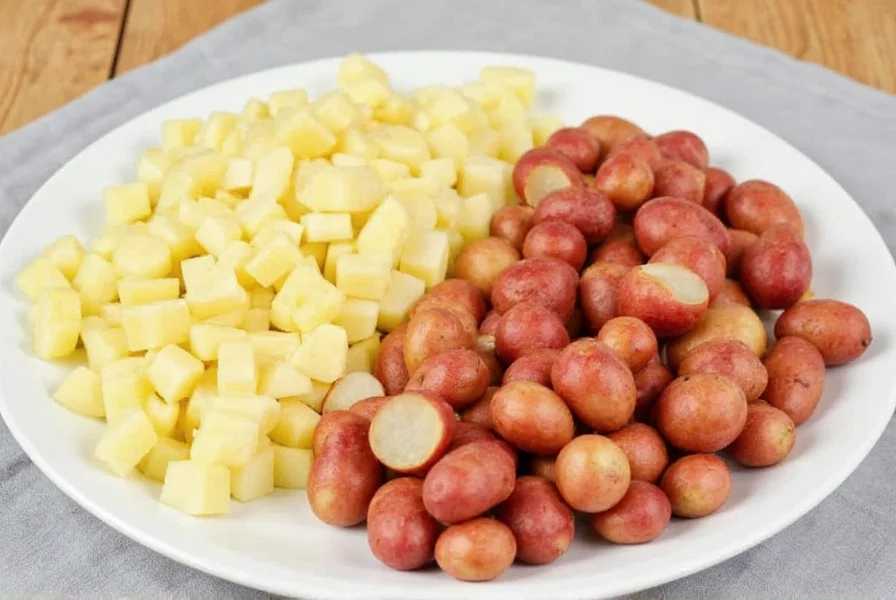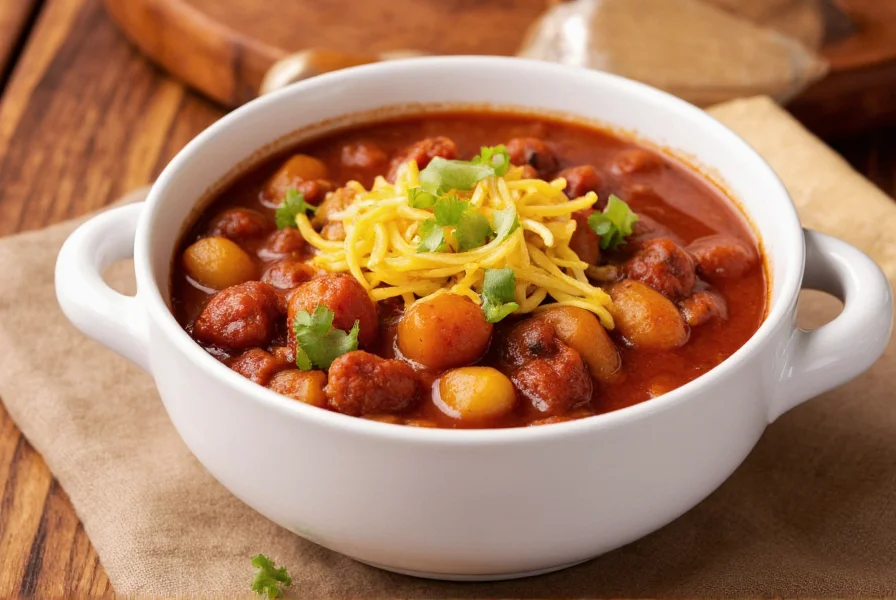Why Potatoes Work Well in Chili Recipes
Contrary to traditional Texas-style chili that focuses solely on meat and peppers, many regional variations across North America incorporate potatoes for practical and culinary reasons. Potatoes transform chili from a soup-like dish into a more substantial meal that satisfies hunger longer. Their natural starch content acts as a thickening agent, eliminating the need for additional thickeners while creating a richer mouthfeel.
From a nutritional standpoint, adding potatoes to chili increases the fiber content and provides essential vitamins like vitamin C and B6. This makes potato chili particularly valuable as a complete meal that delivers carbohydrates, protein, and vegetables in one pot. Many home cooks appreciate how potatoes stretch the recipe, making chili more economical without compromising flavor.
Best Potato Varieties for Chili
Not all potatoes perform equally well in chili. Understanding potato characteristics helps you select the right variety:
| Potato Type | Texture in Chili | Best For |
|---|---|---|
| Yukon Gold | Holds shape well, creamy texture | All-purpose chili, especially dairy-based variations |
| Red Potatoes | Firm, maintains integrity | Heartier chili, longer cooking times |
| Russet | Tends to break down | Thicker chili, rustic preparations |
| Fingerling | Distinctive shape, holds form | Gourmet presentations, specialty recipes |
For most traditional potato chili recipes, Yukon Gold offers the ideal balance between structure and creaminess. Their thin skins don't require peeling, saving preparation time while adding nutrients. Red potatoes work well when you want distinct potato pieces visible throughout the finished dish.

Proper Technique for Adding Potatoes to Chili
The timing of potato addition significantly affects your final dish. Unlike beans that can withstand long cooking times, potatoes require careful attention to prevent overcooking:
- Cut uniformly: Dice potatoes into 1/2-inch cubes for even cooking
- Acid protection: Toss cut potatoes in lemon juice to prevent browning
- Timing matters: Add potatoes during the last 25-30 minutes of cooking
- Test for doneness: Potatoes should be tender but still hold their shape
Adding potatoes too early results in disintegration, creating an unappealing texture. For chunkier chili, parboil potatoes separately for 5 minutes before adding to the chili during the final simmering stage. This technique ensures perfect texture regardless of your chili's total cooking time.
Classic Potato Chili Recipe
This straightforward recipe demonstrates how to incorporate potatoes properly while maintaining authentic chili flavors:
Ingredients
- 1.5 lbs ground beef or plant-based alternative
- 2 medium Yukon Gold potatoes, peeled and diced
- 1 large onion, chopped
- 3 cloves garlic, minced
- 28 oz crushed tomatoes
- 2 tbsp chili powder
- 1 tbsp cumin
- 1 tsp smoked paprika
- 2 cups beef or vegetable broth
- Salt and pepper to taste
Preparation
- Brown ground beef in large pot over medium-high heat
- Add onions and garlic, cooking until translucent
- Stir in spices and cook for 1 minute to release flavors
- Add tomatoes and broth, bringing to a gentle simmer
- Cook for 20 minutes to develop base flavors
- Add diced potatoes and continue simmering for 25-30 minutes
- Season with salt and pepper before serving

Regional Variations and Adaptations
Potato chili appears in numerous regional interpretations across North America. In the American Southwest, Navajo-style chili often includes potatoes alongside traditional ingredients. Canadian chili frequently features potatoes as a standard component, reflecting British culinary influences. For vegetarian adaptations, increase potato quantity by 50% and use vegetable broth to maintain heartiness without meat.
When preparing spicy potato chili variations, add potatoes after reducing heat following the addition of hot peppers. This prevents the potatoes from becoming waterlogged while absorbing just enough heat. For creamier versions popular in Midwestern households, stir in a small amount of cream cheese during the final 10 minutes of cooking.
Avoiding Common Potato Chili Mistakes
Even experienced cooks make these frequent errors when preparing potato chili:
- Adding potatoes too early: Results in mushy texture that disappears into the broth
- Using waxy potatoes exclusively: New potatoes work well but lack the starch needed for proper thickening
- Over-seasoning before potatoes cook: Potatoes absorb salt, potentially creating an overly salty final product
- Stirring too vigorously: Causes potatoes to break apart during cooking
For best results with authentic potato chili preparation, taste and adjust seasoning after potatoes have cooked completely. The starch released from potatoes affects flavor balance, requiring potential adjustments to salt and spice levels at the end of cooking.
Serving Suggestions for Potato Chili
Potato chili's substantial nature means it often requires fewer accompaniments than traditional chili. Consider these serving options:
- Top with fresh cilantro and a dollop of sour cream
- Pair with cornbread for a complete meal
- Use as a filling for baked potatoes (a chili within a chili)
- Serve over rice for an extra-hearty version
- Garnish with pickled jalapeños for added texture contrast
Leftover potato chili often improves overnight as flavors continue to meld. When reheating, add a small amount of broth if the chili has thickened too much from potato starch. Properly stored, potato chili maintains quality for 4-5 days in the refrigerator or up to 3 months frozen.
Frequently Asked Questions
Can I use sweet potatoes in chili instead of regular potatoes?
Yes, sweet potatoes work well in chili, particularly in vegetarian or southwestern-style recipes. They add natural sweetness that balances spicy elements. Use orange-fleshed sweet potatoes cut into 3/4-inch cubes and add during the last 30 minutes of cooking. Note that sweet potatoes have different starch content, so you may need to adjust thickening agents accordingly.
How do I prevent potatoes from becoming mushy in chili?
To maintain potato integrity, add them during the last 25-30 minutes of cooking. Parboiling potatoes separately for 5 minutes before adding to chili helps set their structure. Choose varieties like Yukon Gold or red potatoes that hold their shape better. Avoid vigorous stirring once potatoes are added, and maintain a gentle simmer rather than a rolling boil.
What's the difference between Cincinnati-style chili and potato chili?
Cincinnati-style chili features Mediterranean spices like cinnamon and allspice, served over spaghetti with cheese, while potato chili incorporates diced potatoes directly into the chili mixture. Cincinnati chili rarely includes potatoes as an ingredient, focusing instead on its distinctive spice profile and serving style. Potato chili maintains more traditional chili ingredients with potatoes added for heartiness.
Can I make potato chili in a slow cooker?
Yes, but adjust timing carefully. Add potatoes during the last 2 hours of slow cooking on low setting. If cooking on high, add potatoes during the final 90 minutes. Overcooking in a slow cooker causes potatoes to disintegrate completely. For best results, brown meat and sauté aromatics first before transferring to the slow cooker.
Do potatoes affect the spiciness of chili?
Potatoes can slightly mellow the perceived heat of chili by absorbing some capsaicin, the compound responsible for spiciness. Their starch content also creates a creamier texture that counteracts heat sensation. If you prefer spicier potato chili, add additional peppers after potatoes have cooked, or serve with hot sauce on the side for individual adjustment.











 浙公网安备
33010002000092号
浙公网安备
33010002000092号 浙B2-20120091-4
浙B2-20120091-4